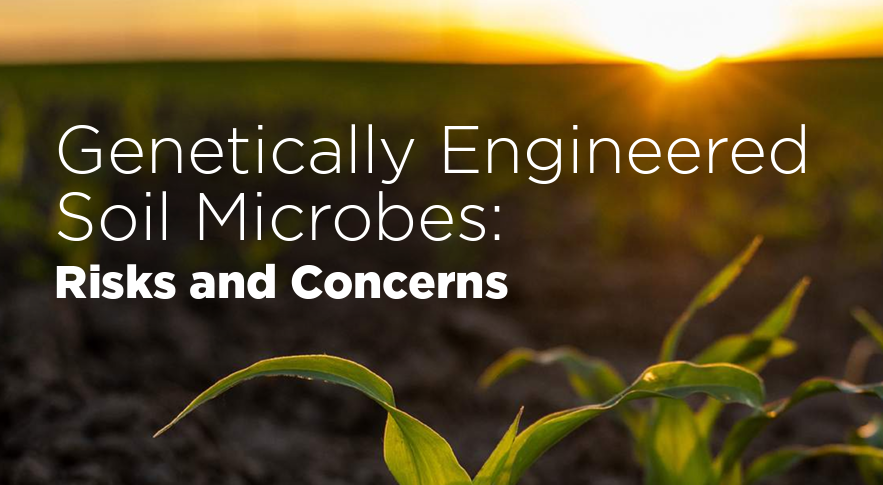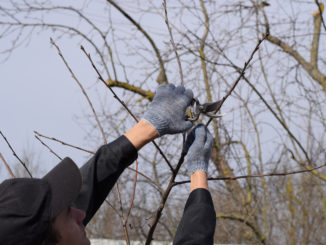
As many Europeans protest against new GMOs (aka NGTs) proposal by the European Commission another area of concern has emerged – soil microbes. It turns out that in the US, the agrochemical industry, without much fanfare, has already introduced commercial products containing new GMO microbes, with many more in the pipeline. So what are the concerns? Marianne Landzettel reports on a new report form Friends of the Earth US.
The proposal by the European Commission to largely deregulate gene editing in plants has been widely criticised by scientists, environmental organisations, food producers, (organic) farmers and others. The issues of concern range from unintended consequences – gene editing techniques are known to cause unintended changes on other parts of the DNA – to the lack of transparency, traceability and labelling.
As many Europeans sign petitions, stage debates and attend protests, out of the US comes a new and extremely concerning report from Friends of the Earth (FOE) U.S. titled: Genetically Engineered Soil Microbes: Risks and Concerns.
Spoiler alert: yes, there are considerable risks and we should be very concerned – in the US, the agrochemical industry, without much fanfare, has already introduced commercial products containing new GMO microbes and many more are in the pipeline.
What’s the issue?
Microbes are tiny, living organisms and they are everywhere – in the air, in the soil, in water, and in us. According to Oregon State University “a single teaspoon (1 gram) of rich garden soil can hold up to one billion bacteria, several yards of fungal filaments, several thousand protozoa, and scores of nematodes”. Only a fraction of these organisms has been identified. What we do know is that they interact in a multitude of ways and are extremely important for plants – their nutrition, their health, their resilience. “Beneficial microbes protect plants from disease by signaling to the plant, secreting protective chemicals in the soil, and competing with pathogens. Microbes can also make nutrients more easily available to plants by releasing them from soil particles or changing their chemical form”, says the FOE US report in the introduction.
Since we started to understand how important microbes are, the industry has been thinking about developing ‘biologicals’ or, more to the point, ‘bug in a jug’ “solutions” which are meant to function as biostimulants to improve plant growth, biofertilisers, or biopesticides. “Today, over 1,200 companies worldwide offer agricultural products derived from naturally occurring microbes and plants”, says FOE. Farmers can choose from many hundreds of such ‘biologicals’.
Why do we need to talk about ‘bugs in a jug’ now?
According to FOE US, we are at a turning point. Big players such as Bayer, Syngenta (ChemChina) and Corteva (Dow-Dupont) have realised that the agrochemicals boom is over, but ‘biologicals’ eventually could make up for the dropping sales of chemical fertilisers and pesticides. FOE estimates that within eight years, from 2021 to 2029, the market for ‘biologicals’ is expected to triple to nearly $30 billion. As before, the real money will be in products made with or containing genetically modified ingredients – which can be patented. In the case of ‘biologicals’ that means gene edited microbes sold “as part of ‘integrated’ platforms, such that the ‘biologicals’ cannot be obtained separately from engineered seeds, pesticides, and other proprietary products (…)”. The products are sold to farmers as a bundle.
What’s the problem?
We know from plants that genetic traits can be transferred within a species from one variety to another – it’s the basis for plant breeding. Microbes are unique in their ability to swap genetic material between species: “Unlike plants and animals, microbes are able to share genetic material with each other far more readily, even across completely unrelated organisms in a process known as ‘horizontal gene transfer.’ As a result, the genetic modifications released inside engineered microbes may move across species boundaries in unpredictable ways”. And that’s the danger: “Releasing GE microbes in agriculture represents an unprecedented open-air experiment that may have irreversible consequences. Once they are released, microbes cannot be ‘recalled.’”
The gen(i)e is already out of the bottle
According to FOE US, at least two products containing genetically engineered microbes are already commercially available to and applied by US farmers. “Proven® consists of live Kosakonia sacchari and Klebsiella bariicola bacteria that have been gene edited to eliminate the ‘off switch’ on the microbes’ process for fixing nitrogen”. The developer, Pivot Bio, is “backed by hundreds of millions in investment funds, including the Gates Foundation and some of the world’s wealthiest individuals.” The product is available as seed treatment for maize, and as in-furrow application for barley, millet, oats, sorghum, sunflower and spring wheat. The company is said to be working with Bayer on a similar product for soybeans. FOE US notes that there is no peer-reviewed research backing up the company’s claim that their product can replace synthetic fertilisers.
A second product, Poncho®/VOTiVO® 2.0. seed treatment, was developed by Bayer and is now is sold by BASF. It combines a neonicotinoid with genetically modified Bt (Bacillus thuringiensis ) bacteria, which supposedly stimulate microbial activity by helping to convert plant residue in the soil into sugars. The product is marketed as a means “to increase nutrient availability to crops”.
The report lists several other companies and universities working on new GMO products – from Salmonella bacteria gene edited to (supposedly) destroy its own cells, to deleting a gene from a fruit tree pathogen to make it less harmful.
Shrouds of secrecy
What is the regulatory process for developing new GMO microorganisms? How many field trials have there been? What are the criteria that have to be met? The US Environmental Protection Agency, EPA, approves field trials, but FOE US says: “There is no way to do a general search for agricultural GE microbes that are going through the regulatory process or that are commercialized”. And the information the US Department of Agriculture is allowed to make public is about as useful as company PR. USDA “allows developers of GE crops and microbes to self-designate unlimited amounts of information as ‘Confidential Business Information’ CBI”.
And it seems that when a company is in a hurry, the EPA is ready to pave the way. According to a recent article from the environmental journalism initiative The New Lede the EPA is ready to approve the commercial use of a gene silencing pesticide for three years before the standard testing period is up. The Colorado potato beetle has become resistant to most chemical pesticides. The active ingredient in the new product, Calantha, is ledprona, “which uses a mechanism called RNA interference (RNAi) to kill the Colorado potato beetle (…) by turning off genes it needs to survive. Calantha would be the first pesticide spray using RNAi.” The EPA gave the approval for field testing the pesticide only in May of this year, but the product may already be commercially available for farmers to apply next spring. The article states that the gene-silencing mechanism could potentially interfere with any species that has similar genetic sequences. And the pesticide might trigger an immune response in humans, which is why the EPA advises anyone handling it to wear a respirator.
Conclusions to be drawn – in the US and Europe
“The current regulatory system is confusing, inadequate and lacks transparency and ongoing oversight. Precautionary, science-based regulations that account for the unique features of genetically engineered microbes should be established ahead of further environmental release and commercialization of these novel technologies”, say Friends of the Earth US. Particularly worrying is not just our lack of knowledge – with only a fraction of soil organisms identified we are very far away from understanding the way they interact. Those are the ‘known unkowns’. The horizontal exchange of genetic material between microbes adds ‘unkown unkowns’ to the list of potential threats. And bacterial cells, fungi and viruses can be carried by the wind over long distances. Once genetically engineered microbes are in the soil we can’t retrieve them and we can’t stop them spreading.
And in the EU?
Pesticides need to be approved for use – but given the pro new GMO stance of the Commission, might such products eventually get the green light? And what about ‘biostimulants’? The Commission proposal would deregulate most neo GMO plants, what rules, if any, apply for these new microbes? The debate is already extremely fraught and complicated, but we cannot afford to overlook what the planned changes would mean for the microbial world.
More
Seeds, New GMOs & Food Policy Councils – Diversity Event Comes to Dublin
A Frugal Farm to Fork – Update on Pesticides, new GMOs, Animal Welfare & Sustainable Food Systems
EU Seed Law Reform and New Genetic Engineering – Double Attack on our Seeds
GMO Deregulation Delayed – Where Are We At, Where Might We Be Going?
European Court Rules Gene Editing to be Subject to GMO Regulation





